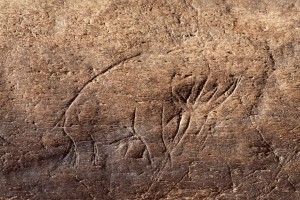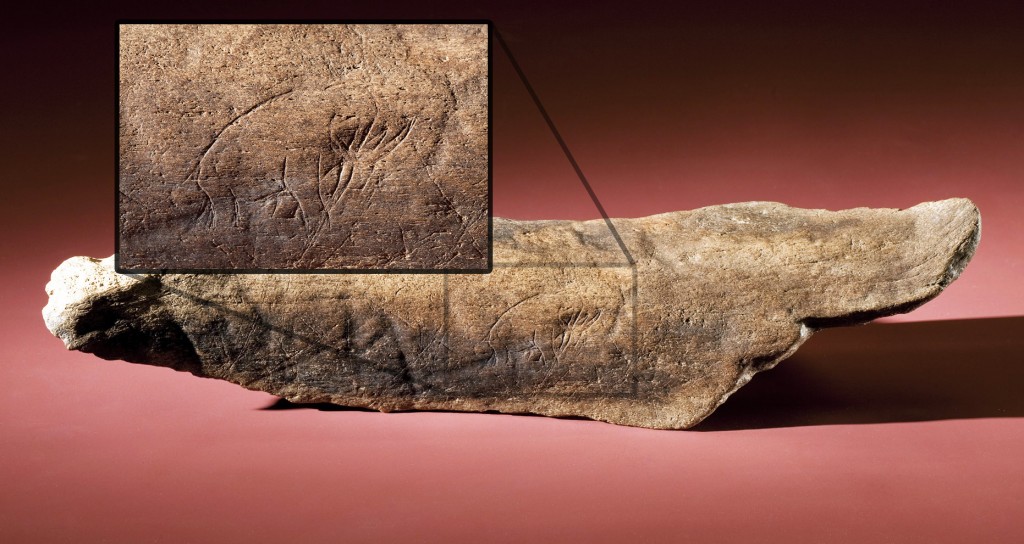 Researchers from the Smithsonian’s National Museum of Natural History and the University of Florida have confirmed in a new study published in the Journal of Archaeological Science that an engraved fossilized bone fragment discovered by an amateur fossil hunter in Vero Beach, Florida four or five years ago is at least 13,000 years old and is thus the first, and so far only, Ice Age image depicting a trunked animal ever found in the United States.
Researchers from the Smithsonian’s National Museum of Natural History and the University of Florida have confirmed in a new study published in the Journal of Archaeological Science that an engraved fossilized bone fragment discovered by an amateur fossil hunter in Vero Beach, Florida four or five years ago is at least 13,000 years old and is thus the first, and so far only, Ice Age image depicting a trunked animal ever found in the United States.
The engraving is of a mastodon or a mammoth and was done on a bone that once belonged to a mammoth, mastodon or giant sloth. There are all kinds of ancient depictions of mastodons and mammoths on cave walls and engraved on bones in Europe, but even though we know from the fossil record that proboscideans (trunked animals) existed in the Americas, this is the first human representation of one found.
Fossil aficionado James Kennedy discovered the bone in 2006 or 2007 (he can’t quite recall) and put it in a cabinet under his sink where it remained until 2009 when he fished it out and dusted it off. It was only after cleaning it that he saw the engraving and contacted scientists at the University of Florida, the Smithsonian’s Museum Conservation Institute and National Museum of Natural History who took custody of the object and began to study. Kennedy told National Geographic in 2009:
“I had no idea it was this big of a fuss. [When I heard] there was nothing else like it in the Western Hemisphere, that’s when my heart kind of stopped.”
Initial analysis performed by the researchers consistently pointed to both fossil and engraving being genuine and ancient, but it has taken a full two years for the team to complete the study and publish the final results. Their initial departure point was skepticism because nothing of its kind had been found before, and even if the fossil was genuine, the engraving could well have been a modern hoax modeled after similar ones in Europe.
Kennedy found the bone near the Old Vero site, the spot where geologist Elias Howard Sellards found human bones lying side-by-side with the bones of extinct Ice Age animals in an excavation between 1913 and 1916. He concluded that humans had hunted animals at Vero Beach during the last Ice Age, but his claims have been disputed ever since.
The team compared the elemental composition of the engraved bone to other comparable fossils discovered at the Old Vero site. Rare earth element analysis indicated the fossil was ancient and originated at or around the Old Vero site. Since mammoths, mastodons and giant sloths died out in the area about 13,000 years ago, the bone must be older than that. Forensic examination of the engraving indicated that it was not recent, but rather aged and mineralized along with the bone.
Optical microscopy results show no discontinuity in coloration between the carved grooves and the surrounding material indicating that both surfaces aged simultaneously. Scanning electron microscopy (SEM) revealed that the edges of the inscription are worn and show no signs of being incised recently or that the grooves were made with metal tools. In addition, the backscattered SEM images suggest there is no discontinuity in the distribution of light and heavy elements between the scribed region and the surrounding bone indicating that both surfaces aged in the same environment. This is very different from an intentional mark made on the bone for comparison. Energy dispersive x-ray spectroscopy (EDXS) shows that the surface contains significant amounts of calcium, phosphorus, oxygen, and carbon typical of a mineralized bone surface. Examination of a cast and mold of the incised bone by Reflectance Transformation Imaging (RTI) also provided no evidence that the engraving was made recently.
The data are thus conclusive enough for the researchers to announce that this is indeed the first mastodon/mammoth representation ever found in the Americas.
The bone is still squirreled away in the lab for now, but you can see a cast of it at the Florida Museum of Natural History in Gainesville. Its future is in question. In 2009, Kennedy said he was undecided about whether to sell it or donate it to the Florida Museum of Natural History. Here’s hoping he’s made up his mind to do the right thing and give it (or sell it, for that matter) to a museum.

“The bone is still squirreled away in the lab for now…” Wow!!! 13,000 years ago in Florida, squirrels had trunks! Who knew?!
Yuk yuk. :chicken:
Can we get another “Yuk Yuk” on “my heart kind of stopped”???
Let’s not goad the man until the bone is safely in the permanent collection of a museum.
Giant sloth? GIANT SLOTH!
IT
IS
MEGATHERIUM!
or I guess Eremotherium due to the location.
Eremotherium doesn’t have the same cachet.
i got offered 16000000 for it today. if u suffer from jealousy that bad that ota give you a reason to kick ur cat. sincerely; james kennedy.
Well, if you’re for real, and I hope you’re not, I can understand finding it impossible to walk away from that kind of money. You’d be set for life.
I don’t see where jealousy enters into it. History matters to me. Seeing one-of-a-kind pieces of the human story disappear into private collections never to be heard from again saddens me deeply.
Perhaps you could stipulate that it be loaned to the Florida Museum of Natural History as a condition of sale.
The Real Story of Vero Beach Wasn’t Ancient Mammoth Art but Rather; Ancient Mammoth Humans and Mammoth Archaeological Misdirection
There could be no better metaphor for modern science, particularly archaeology than Dr. Zaius from the movie “Planet of the Apes”.
When that Minister of Science found the talking human doll in a cave which would have overturned his scientific paradigm he had the cave sealed and the eyewitnesses arrested.
This week, the Huffington Post published a story about ancient mammoth art discovered at Vero Beach Florida which managed to both bury the lead and to seal the real archeological experience of North America in a cave, metaphorically speaking.
The original article announcing this discovery was published in 2009 so it’s a bit of a mystery why this article is being published now. (We had our own article last year). However, here is an offensive quote from the article:
“While prehistoric art depicting animals with trunks has been found in Europe, this may be the first in the Western Hemisphere, researchers report Wednesday in the Journal of Archaeological Science”http://s8int.com/WordPress/?p=2905
The Ice Age is not a very old concept. It was not thought of in the 1700s, just like the theory of evolution was not widely known then either. This theory only gained ground in the 1840s when two researchers, Charpentier and Agassiz, tried to explain the forms of the Alps by the theory and later expanded it to apply to the whole of Northern Europe. It is surprising that this theory came to light almost at the same time as Darwin’s idea of the origin of species. Both of these theories gained simultaneous attention in the society of that time.
It has been thought that there have been several Ice Ages on the Earth. It has even been said that tropical and hot areas like the Sahara, Africa, Saudi Arabia, Yemen, Australia, India, Madagascar, and South America (as presented in the books Jääkausi (Ice Age) / Björn Kurten and Muuttuva maa / Pentti Eskola, for example) were covered with a large continental glacier tens of millions of years ago. The latest Ice Age is assumed to have started “just” about 500,000 years ago and ended 10,000 years ago. The ice sheets are believed to have covered at their widest 55 million square meters, and the thickness of the ice was at most over 3 kilometers (about 1.8 miles).
What should we think about the Ice Age? Have we any reason to believe in it? Maybe the signs that have been interpreted as signs of an Ice Age were caused by something else? We will now study the mystery of the Ice Age.
http://www.jariiivanainen.net/Has_there_ever_been_the_ice_age.html
This is Michele Gillen from CBS MIami. I would to speak with you. I can be reached at
mgillen222@aol.com
Thank you! What an amazing story and find!
Telson asks: “Has there ever been an ice age?”
Yes.
As to cooking a mastodon, I’m reminded of a Native America whale recipe I once ran across which began, “First, invite all your friend, for you’re going to have a lot of food.”
i have a mammoth foot bone and a way cooler carvin hell i got a few yall want em make offers i have a massive collection all can be authenticated
seriously i have many for sale i live in holden mo
If you think that being in a museum makes items eternally safe you’ve got a lot to learn.
Having blogged many times about museum thefts, I’d be less naive than deeply impaired to think placement in a museum makes an artifact “eternally safe.” Nothing is eternally anything.
My point is that it’s a desperate shame for artifacts of such rarity and historical significance to disappear down the rabbit hole of private collections where people can’t see them and scholars can’t study them unless the owner is unusually magnanimous.
Bud, you are fooling yourself if you think that “authentication” means anything about the artifact. There is no telling how many fakes ares accompanied by a piece of paper signed by somebody who “authenticates” artifacts. You might as well save your money.
:yes: It came after the global warming we have every few century`s, but try and tell that to the bankers that listen to the politicians who want you to pay for carbon taxes
First, that has nothing to do with the article.
Second, carbon taxes would be paid by power companies and heavy industry. Most people are neither of those things.
Sunday night, the New England Revolution climbed the table with a 2-1 victory over the Chicago Fire at Gillette Stadium for a small crowd of
12,204. During ancient times, the Greeks and the Romans played many types of ball games and a few
prominent ones resembled the present-day football.
If you have a huge enough group you can compete from
just about every other on the battle discipline, or group with each other
and take on an enemy.
I am so happy that you found this needle in a haystack as it not only is worth millions but it is about to twist the necks of a lot of stiff necked people
:yes: